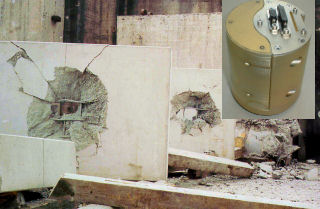Here is a long thread about conventional missile fuzes. It explains why Taurus offers a qualitative edge over Storm Shadow/SCALP-EG when engaging certain targets, and why it’s one of the most advanced conventional weapons currently in the arsenals of Western states. 👇🧵1/21




A fuze is a device that detonates a munition's explosive material under specified conditions. In other words, the fuze makes sure that your payload explodes when & where you want it to. Not sooner, not later. As such, it is a critical part of the missile’s warhead system. 2/21 

Storm Shadow/SCALP-EG and Taurus are cruise missiles primarily designed to engage hardened and buried targets. To do so, they are equipped with a powerful multi-effect warhead consisting of a primary shaped charge and a secondary follow through bomb (FTB) or penetrator. 3/21 

Depending on what type of target you are engaging, you may want the follow through bomb not only to penetrate the engaged structure as deep as possible before exploding, but to explode at a very specific depth or moment to maximize the damage caused. 4/21
For example, when engaging a multi-story bunker, you might want the follow through bomb to explode at a certain level. When engaging a bridge, you may want the FTB to penetrate the first layer (the bridge deck) and only detonate in the second layer (the pillar). 5/21




How do you do this? This is where the fuze comes in. Storm Shadow/SCALP-EG’s BROACH warhead system uses the so-called Multi-Application Fuze Initiation System (MAFIS), which you also find in several American weapon systems, such as the AGM-154 JSOW gliding bomb. 6/21 

MAFIS is a more or less “traditional” time fuze where the delay of the follow through bomb’s ignition can be manually set in steps from 0-240 milliseconds. I.e., the penetrator is ignited after a predetermined amount of time following the “shock” of the initial penetration. 7/21 

The problem with this fuze design is that you have to estimate the delay correctly. For example, if I overestimate the time it will take the follow through bomb to penetrate the layer(s), it will explode too late. If I underestimate the time, it will explode too early. 8/21 

This likely happened when Ukraine used Storm Shadow for the first time in late June to engage the Chonhar bridge. The missile managed to penetrate the bridge deck effortlessly but the pillar remained rather untouched, likely because the follow through bomb ignited too early. 9/21 

Engaging bridges with time fuzed bombs is especially problematic, given that modern bridge decks are rarely even. Time of penetration will depend on whether the FTB hits a point under which there is only the bridge deck, a girder/beam, or the deck & one side of a girder. 10/21 

How can we improve on this less accurate time fuze design? One way would be to count the layers and “void spaces” the FTB penetrates, in order to time the ignition. In doing so, we no longer rely on an estimated penetration time, which is bound to be inaccurate. 11/21
Coincidentally, this is exactly what the fuze of Taurus’ MEPHISTO warhead system does. Taurus’ warhead is equipped with a “void sensing and layer counting” fuze called PIMPF (Programmable Intelligent Multi-Purpose Fuze). 12/21 

This fuze counts the layers and void spaces the follow through bomb penetrates to ignite the payload at exactly the right moment. By measuring the speed of deceleration, PIMPF can also recognize different types of layers (concrete, rock, soil, etc.). 13/21 

This fuze design also offers benefits when engaging bridges. Rather than relying on an estimated time of penetrating the bridge's first layer (the bridge deck), you can tell the fuze to ignite the follow through bomb once it penetrates the second layer (the pillar). 14/21
In doing so, you not only damage the deck of the bridge, but you can also damage its foundations. One missile equipped with a void sensing & layer counting fuze can therefore cause the damage that previously could only be achieved with two or more accurately dropped bombs. 15/21
I stand by what I said in the past. 90% of why 🇺🇦 needs Taurus is to prevent its long-range strike arsenal from running low. However, Taurus also provides a qualitative edge. If 🇺🇦 receives Taurus, 🇷🇺 bridges will be in an even more precarious spot (👀Kerch bridge). 16/21
This fuze design is also really useful in anti-ship missiles, because you can guarantee ignition of the warhead after the ship’s hulls have been penetrated. Kongsberg’s NSM, which is currently scoring one contract after another, uses the same PIMPF fuze as Taurus. 17/21 

Taurus’ advanced fuze system is what renders the cruise missile a state-of-the-art weapon system. While newer cruise missiles, such as JASSM, are likely stealthier due to incorporating more and better low-observability features, Taurus’ warhead design does not lag behind. 18/21 

In fact, TDW (the Bavarian/German company manufacturing PIMPF) cooperated with American companies to adapt PIMPF for American purposes. The resulting and adapted fuze is now used in several American weapon systems, including JASSM (FMU-156/B). 19/21




PIMPF is also one of the reasons why South Korea is relying on the Taurus cruise missile as one of its key weapon systems in its "Kill Chain" missile strike system which aims at deterring South Korea's nuclear-armed neighbor by threatening conventional counterforce strikes. 20/21 

As it turns out, Oktoberfest is only the second best thing to have come out of Bavaria, after TDW’s PIMPF. Deliver Taurus without targeting restrictions and see Kerch Bridge (and other bridges) go up in flames. #FreeTarus /END 

• • •
Missing some Tweet in this thread? You can try to
force a refresh











